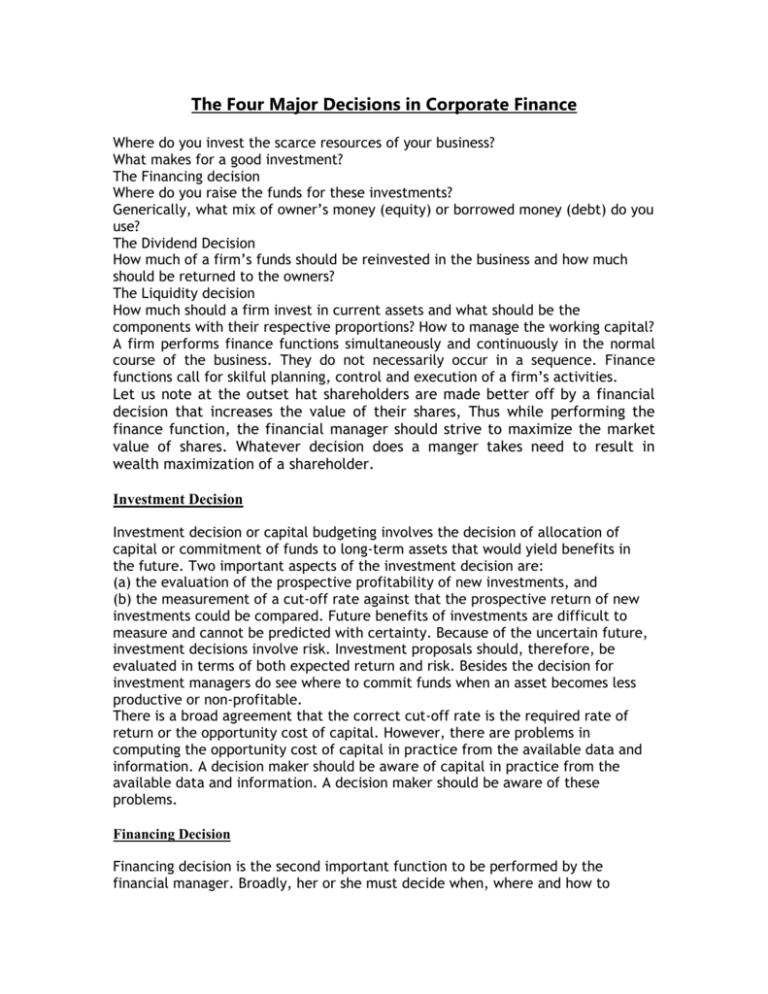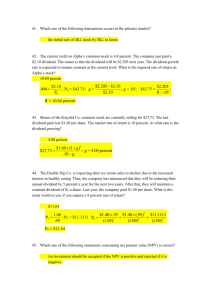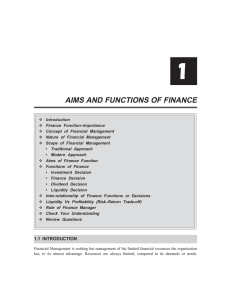The Four Major Decisions in Corporate Finance
advertisement

The Four Major Decisions in Corporate Finance Where do you invest the scarce resources of your business? What makes for a good investment? The Financing decision Where do you raise the funds for these investments? Generically, what mix of owner’s money (equity) or borrowed money (debt) do you use? The Dividend Decision How much of a firm’s funds should be reinvested in the business and how much should be returned to the owners? The Liquidity decision How much should a firm invest in current assets and what should be the components with their respective proportions? How to manage the working capital? A firm performs finance functions simultaneously and continuously in the normal course of the business. They do not necessarily occur in a sequence. Finance functions call for skilful planning, control and execution of a firm’s activities. Let us note at the outset hat shareholders are made better off by a financial decision that increases the value of their shares, Thus while performing the finance function, the financial manager should strive to maximize the market value of shares. Whatever decision does a manger takes need to result in wealth maximization of a shareholder. Investment Decision Investment decision or capital budgeting involves the decision of allocation of capital or commitment of funds to long-term assets that would yield benefits in the future. Two important aspects of the investment decision are: (a) the evaluation of the prospective profitability of new investments, and (b) the measurement of a cut-off rate against that the prospective return of new investments could be compared. Future benefits of investments are difficult to measure and cannot be predicted with certainty. Because of the uncertain future, investment decisions involve risk. Investment proposals should, therefore, be evaluated in terms of both expected return and risk. Besides the decision for investment managers do see where to commit funds when an asset becomes less productive or non-profitable. There is a broad agreement that the correct cut-off rate is the required rate of return or the opportunity cost of capital. However, there are problems in computing the opportunity cost of capital in practice from the available data and information. A decision maker should be aware of capital in practice from the available data and information. A decision maker should be aware of these problems. Financing Decision Financing decision is the second important function to be performed by the financial manager. Broadly, her or she must decide when, where and how to acquire funds to meet the firm’s investment needs. The central issue before him or her is to determine the proportion of equity and debt. The mix of debt and equity is known as the firm’s capital structure. The financial manager must strive to obtain the best financing mix or the optimum capital structure for his or her firm. The firm’s capital structure is considered to be optimum when the market value of shares is maximized. The use of debt affects the return and risk of shareholders; it may increase the return on equity funds but it always increases risk. A proper balance will have to be struck between return and risk. When the shareholders’ return is maximized with minimum risk, the market value per share will be maximized and the firm’s capital structure would be considered optimum. Once the financial manager is able to determine the best combination of debt and equity, he or she must raise the appropriate amount through the best available sources. In practice, a firm considers many other factors such as control, flexibility loan convenience, legal aspects etc. in deciding its capital structure. Dividend Decision Dividend decision is the third major financial decision. The financial manager must decide whether the firm should distribute all profits, or retain them, or distribute a portion and retain the balance. Like the debt policy, the dividend policy should be determined in terms of its impact on the shareholders’ value. The optimum dividend policy is one that maximizes the market value of the firm’s shares. Thus if shareholders are not indifferent to the firm’s dividend policy, the financial manager must determine the optimum dividend – payout ratio. The payout ratio is equal to the percentage of dividends to earnings available to shareholders. The financial manager should also consider the questions of dividend stability, bonus shares and cash dividends in practice. Most profitable companies pay cash dividends regularly. Periodically, additional shares, called bonus share (or stock dividend), are also issued to the existing shareholders in addition to the cash dividend. Liquidity Decision Current assets management that affects a firm’s liquidity is yet another important finances function, in addition to the management of long-term assets. Current assets should be managed efficiently for safeguarding the firm against the dangers of illiquidity and insolvency. Investment in current assets affects the firm’s profitability. Liquidity and risk. A conflict exists between profitability and liquidity while managing current assets. If the firm does not invest sufficient funds in current assets, it may become illiquid. But it would lose profitability, as idle current assets would not earn anything. Thus, a proper trade-off must be achieved between profitability and liquidity. In order to ensure that neither insufficient nor unnecessary funds are invested in current assets, the financial manager should develop sound techniques of managing current assets. He or she should estimate firm’s needs for current assets and make sure that funds would be made available when needed. It would thus be clear that financial decisions directly concern the firm’s decision to acquire or dispose off assets and require commitment or recommitment of funds on a continuous basis. It is in this context that finance functions are said to influence production, marketing and other functions of the firm. This, in consequence, finance functions may affect the size, growth, profitability and risk of the firm, and ultimately, the value of the firm. To quote Ezra Solomon The function of financial management is to review and control decisions to commit or recommit funds to new or ongoing uses. Thus, in addition to raising funds, financial management is directly concerned with production, marketing and other functions, within an enterprise whenever decisions are about the acquisition or distribution of assets. Various financial functions are intimately connected with each other. For instance, decision pertaining to the proportion in which fixed assets and current assets are mixed determines the risk complexion of the firm. Costs of various methods of financing are affected by this risk. Likewise, dividend decisions influence financing decisions and are themselves influenced by investment decisions. In view of this, finance manager is expected to call upon the expertise of other functional managers of the firm particularly in regard to investment of funds. Decisions pertaining to kinds of fixed assets to be acquired for the firm, level of inventories to be kept in hand, type of customers to be granted credit facilities, terms of credit should be made after consulting production and marketing executives. However, in the management of income finance manager has to act on his own. The determination of dividend policies is almost exclusively a finance function. A finance manager has a final say in decisions on dividends than in asset management decisions. Financial management is looked on as cutting across functional even disciplinary boundaries. It is in such an environment that finance manager works as a part of total management. In principle, a finance manager is held responsible to handle all such problem: that involve money matters. But in actual practice, as noted above, he has to call on the expertise of those in other functional areas to discharge his responsibilities effectively. Vanshjain.caclubindia.com








